
+256-782-930-341

Office Hours:
Monday - Saturday

Construction site visit
- Post published: 11/03/2022
- Post category: Real Estate Development
- Post comments: 0 Comments
- Post last modified: 11/03/2022
- Reading time: 5 mins read
Construction site visits are an important part of the construction process. The purpose of the site visit is to take a look at the site, assess any potential problems, and provide feedback on the work that has been done.

The following are some reasons for conducting a construction site visit:
– To assess any potential problems with the work already completed
– To provide feedback on work done so far
– To determine if there are any unforeseen obstacles or issues that need to be addressed
A site visit is a visit to a construction site. Site visits are usually conducted by clients, architects, and other stakeholders before the project is complete.
Site visits can be done in person or virtually using 3D models or video.
Site visits are often used to review construction progress, identify potential risks and hazards, and confirm that the work is being done according to the design specifications.
In order for a site visit to be successful, it is important that all parties involved have an understanding of what they will be looking for during their visit and what information they will need from each other.
The following questions should be discussed before a site visit:
-What are the objectives of the site visit? -What inspection methods might we use onsite? -How will we
Site visits are a great way to learn more about the construction process.
You may have heard that site visits are a great way to learn more about the construction process. But what is it like to visit a construction site?
A site visit is an opportunity for you to see how your home or business will be built. You’ll get a chance to see how work is progressing and ask questions. It’s also an opportunity for you to meet with your builder and architect, who can answer any questions you might have about the project and its progress.
The best part of visiting a construction site is that it gives you an idea of what it will be like when your home or business is finished and it’s ready for occupancy.
A site visit is a meeting or inspection of a building site by an engineer, architect, or other consultant. The purpose of the site visit is to verify that the construction is progressing according to plan and to assess any risks, including potential hazards and safety issues.
A site visit usually involves:
– Assessing the progress of construction work against the design drawings
– Verifying compliance with building codes
– Identifying risks and making recommendations for remedial action
– Conducting inspections for safety purposes http://8-must-dos-in-scheduling-construction-site-visits/
Site visits are a great way to get first-hand insights on how the project is progressing.
It is traditionally assumed that site visits involve going to sites and examining them for defects, workmanship, materials and equipment, and that if the conditions are not satisfactory, requiring corrective action by the site managers. This can be for one reason or another.
Site managers who receive inspection visits must be prepared to schedule them accordingly with appropriate supervision, unless they are scheduled out of consultation with sufficient lead time from senior management.
Site visits are a very important part of construction. The way a site visit is carried out depends on what type of building is being built or constructed.
Site visits are typically carried out to survey the construction progress, to make sure all the required materials needed for the process are in order, and most importantly to make sure that everything is being done as planned.
If there were no site visits, it would be difficult for contractors and clients to know if any obstacles had arisen, or if mistakes were made by either party during construction. Site visits also help detect functionality issues and design error. Furthermore, a lot of times site staff lawyers will not allow prospective tenants or buyers who desire to visit the building enter on their own before inspection has been made by either one of the parties (property owner).
A construction site visit is classified as “an inspection of a construction project carried out with a view to establishing facts such as the progress of works, materials on site, and equipment’s as well as identifying hazards or problems in order to decide what might be done better or differently
Construction site visit to happen at least once per shift
1 out of 5 construction workers report that their site visits don’t happen often enough
One major challenge with a construction site visit is that it identifies hazards and risks but does not provide viable solutions. The root cause may have caused from lack of maintenance or improper installation.
A thorough investigation must always be performed before safety remedies are put in place and workers subjected to any danger. https://gotinoconstruction.com/construction-site/
You Might Also Like

How thick does concrete need to be to not crack?

What are the 4 main types of residential roofing
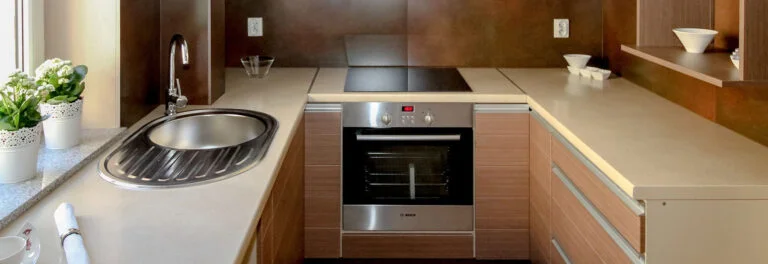
House decorating tips
Leave a reply cancel reply.
Save my name, email, and website in this browser for the next time I comment.
Useful Links
Corporate locations.
Plot number 481 and Block number:98, Nsambwe, Mukono
Lira Branch:
Odokomit behind Totco-Ober Road
+256-782-930-341 or +256-700-395-162
Privacy Overview
Terms of Service - Privacy Policy
- Capacity Building
- Collaboration
- Communication
- Field Building
- Funder Approach
- Outcomes & Impact
- RFPs & Competitions
- Sustainability
- Transparency
- Arts & Culture
- Civic Engagement
- Community Development
- Economy & Workforce
- Emergency & Disaster
- Environment
- Human Rights
- Peace & Conflict
- Science & Technology
- Candid Features
- Case Studies
- Curated Content
- Guided Reading
- Infographics
Conducting a Meaningful Site Visit
A site visit can be one of the most important tools you use, as a grantmaker, in determining your ultimate funding decisions. For example, an in-person look at a potential grantee’s activities can complement a grantee’s written proposal and give you a clearer picture of their request. In fact, site visits can be one of the most interesting parts of the grantmaking process.
What makes a site visit meaningful? Careful preparation, mutually understood goals, a willingness to see the event as part of an ongoing relationship. So how can you be a "good guest" while conducting a structured, but not stifling, site visit? Here grantmakers offer some helpful advice for:
"It's not surprising to feel a little nervous about site visits. One way to orient yourself is to put yourself in the shoes of the applicant and imagine how you'd like to be treated. Often, puzzles about what to say or how to say it will become immediately clear."
— A grantmaker recalling a first experience with site visits
Managing Your Role
Since the business of making grants primarily involves establishing a relationship between the grantor and the grantee, grantmakers often conduct site visits precisely to develop firsthand relationships with leaders and organizations in the communities and fields on which they focus. As such, a site visit can serve as an open-ended interview that allows you to ask pressing questions you may have and let potential grantees discuss the things they love to do. Talking at length and in depth with applicants about their work, and making certain they understand the fundamental purposes of your grant-making program, can also sometimes lead to exciting new ideas.
It can be a mistake, though, to think of a site visit as a discrete, one-time-only event. Site visits and one-to-one conversations are more likely to be continuing activities — at least with organizations directly involved in your program areas. Consequently, you may decide to make your first site visit to some organizations before you circulate a request for proposals, as a get-acquainted step, or as an element of your overall reconnaissance. Later, another visit may be part of your consideration of the group’s proposal. If you decide to award a grant, there are likely to be other visits — within reason — down the road, either to monitor the grant or maintain good relations.
Bear in mind that few organizations turn down a funder’s request for a meeting. They may be in the midst of their busiest season, rushing to prepare a proposal for another funder, or simply overwhelmed with work — they’ll probably still set aside two hours for you. As valuable as site visits can be, therefore, it’s important to make sure you’re not imposing on the organization’s time or distracting its staff. Remember: the organization is not likely to tell you — at least at first — that your request for a meeting comes at a bad time. You need to be alert and sensitive, and hope that at some point the group feels free to be more candid with you about its schedule.
Before You Visit
If the site visit is a first contact, do some homework. If you have not yet received a proposal from the organization, visit its Web site, if one exists, or research its area of work. This preparation allows you to use the time you spend with potential grantees efficiently, to ask pertinent, informed questions, and to understand what they’re trying to accomplish.
Even if the contact isn’t a new one, prepare yourself and the grantee before the visit. Be thoughtful and clear. For example, you might explain that you want to learn more about a particular aspect of the organization’s work. In any case, let them know how much time you have, and whether there are particular people or activities you would like to see.
Formulate some preliminary questions — but be careful of coming up with a long list. Narrow it down to the three most important ones, so as not to overwhelm your host. Notify the potential grantee of your questions ahead of time. You might also suggest that the organization send you an agenda of its own for the visit.
If possible, schedule site visits at times when you can observe some type of program activity. It helps to experience the work of the potential grantee firsthand.
While it can be helpful to conduct your visit with other staff from your foundation — the added perspective may be valuable — remember that having too many additional people can make it hard to have an informative, relaxed conversation.
Be aware that a site visit is a very important event to potential grantees. They will quite likely put a lot of energy into planning it and will hope to have your full attention. Difficulties in scheduling can create a misleading impression, as one grantmaker learned: "I remember a time when one of our team had to leave after half an hour. It wasn’t disrespectful; it was just someone juggling a tough working schedule. But it seemed as though perhaps we weren’t really that interested."
During the Visit
Begin by reminding people of the reason for your visit and about your role. You may have explained these points already, but nonprofits often play host to visitors, and may not remember what you told them. Be sure they understand that you’re there not only as an interested individual, but as your organization’s representative.
Since everyone's time is scarce, you may want to focus on what you most need to know to make a good grant, and on matters that call for the prospective grantee's impressions, interpretations, and personal reflection. In other words, the site visit is not usually the best time to bring up small, detailed matters that may require the applicant to do research or analysis. It is an opportunity to get to know the organization in a more personal way than is possible on paper
As the Visit Concludes
Don't forget to use the visit as an opportunity to expand your knowledge of the broader community or field. Ask applicants for suggestions about other organizations or activities that you should be looking at, or other people you should get to know.
Leave room for excitement: surprisingly good things can happen during a site visit. "I remember one visit," notes an experienced grantmaker, "when, after about an hour-and-a-half of talk and examination of the premises, the prospective grantee deferred going to another meeting so he could fill us in on his ideas for several different possible grants. It was a lively discussion, and I think curtailing it would have curtailed the making of the grant. You have to leave room for excitement."
And a final note. If the first one or two visits start off stiffly, don't worry. It takes more than an hour or two, and often more than a single visit, to establish the kind of trusting, open relationship in which a real exchange of ideas — the "excitement" — can take place.
Learning from Site Visits (Funding Community Organizing) Managing Expectations: Site Visits (Saying Yes / Saying No)
Takeaways are critical, bite-sized resources either excerpted from our guides or written by Candid Learning for Funders using the guide's research data or themes post-publication. Attribution is given if the takeaway is a quotation.
This takeaway was derived from Building Community Inside and Out .
Content type
Related content, your candid learning for funders.
- Registration
- Content Feeds
- About the Website
- About Candid Learning for Funders
- Journal Guidelines

8 Reasons Why Site Visits Are The Best Learning Experience

Whether you are just starting out in the field of architecture or an architect with 40 years of experience, site visits play a central role to our professional development. Most of the times, site visits take place during the construction phase of a project. It is during this stage where a team of multidisciplinary professionals physically get together to realize things previously drawn on paper in real, three-dimensional space. This long and complex process inevitably presents a series of challenges, but precisely so, it offers unique learning opportunities for architects , designers , and everyone else involved. From gaining professional knowledge to developing important life skills, here are eight reasons why site visits are the best learning experience:

1. Site visits allow for an authentic and accurate experience of the space.
While we may think we know a space or building inside out from all the overtime put into drawing plans, elevations, and sections, not to mention creating photorealistic renderings, site visits might prove that the actual space turns out looking and feeling a lot different from what we had envisioned. Physical factors such as time of day, temperature, and human traffic all affect our perception of a space or building, but the effects of these can never be conveyed sufficiently through mere two-dimensional drawings and it is by being on-site that we experience these factors at work and get an accurate understanding of the space.
2. Sometimes, site visits before the design phase of a project is crucial in helping us understand the local culture of a place.
When a project is located in a place unfamiliar to us, a site visit not only allows us to conduct site analysis, but also exposes us to the local way of life and the unique culture of the place. No amount of research in the office can beat being on-site and being physically and psychologically immersed within the environment. This is important so that we can create design solutions that are sensitive and responsive to the particular needs and characteristics of a place.
3. We learn most of the specifics of construction and construction methods on-site.
It is widely agreed among professionals that architectural education in schools rarely does a good job of exposing students to methods of construction. Schools are focused on teaching students to think conceptually and to sell their architectural designs, but when it comes to actual materials and construction, being on-site lets us witness how different materials and components come together and the processes and mechanisms involved in building. In fact, ask any professional in the field and they are likely to tell you that most of their knowledge of construction came from years of on-site experience.
4. Site visits allow us to learn from the expertise of other professionals.
Most of the times, site visits mean meeting professionals of other fields. Through our discussion of problems and solutions with professionals such as engineers, contractors, and electricians, we not only gain knowledge of other disciplines that will be helpful to our work, but more importantly see their expertise being applied in real life on the job site. Understanding aspects of a design from their perspective also helps us foresee and prevent potential problems in our design proposals.
5. Site visits expose us to concerns of safety.
Probably one of the first images that comes to mind when we speak of a construction site is that of people wearing helmets, and this shows just how important safety is on-site. When drawing or specifying a curtain wall glass panel on the computer, we do not have to personally deal with the physicality and weight of this massive material. At a site visit, however, the physical presence of large and heavy materials poses an immediate threat to our safety. An awareness of on-site safety is crucial to a smooth and successful construction process.
6. Site visits train us to think and make decisions on our feet.
When a project runs into a problem at the construction site, architects and designers often need to have discussions with other professionals to arrive at a decision on the spot. From a substitution of materials to signing an agreement, these things force us to be alert to various factors and consequences under a tight time constraint. Many of these decisions have major impacts on a project timeline and cost, so it is important to have the critical awareness and thinking skills needed to make such decisions when they are required of us.
7. Discussions and negotiations during site visits build our interpersonal and communication skills.
As different disciplines often have different methods of working, discussions and negotiations with a multidisciplinary team on-site require us to have good communication skills so that we can effectively convey our thoughts and relate to everyone involved. These conversations allow us to build interpersonal skills and learn from the various communication and working strategies of other professionals so that we become better at collaboration, management, and leadership.
8. When things do not go as planned, site visits let us understand why and how a design failed.
Sometimes, what we draw as two-dimensional plans, elevations, sections, and construction details fail to translate successfully into three-dimensional realities. It is useful to see the physical space or materials and talk with other professionals on-site to understand exactly how and why a design did not turn out the way we envisioned. Such experiences will give us the necessary foresight to prevent similar mistakes in the future projects.

Ultimately, site visits not only allow us to gain more technical and practical knowledge about materials and construction processes, but also offer opportunities to build valuable life skills that we can apply in our daily lives. Nonetheless, all these learning opportunities are only as much as we make of them. By paying more attention to the processes and complexities at a site visit, we might make our experience much more interesting and meaningful than it appears to be.

Lisa graduated in 2018 with a Bachelor’s degree in interior design and a few internship experiences. She is currently completing her Master’s degree in art history and studying architectural renderings for her thesis. Her passion is thinking critically about everything architecture: from architectural movements to contemporary professional practices.

Yi’s House Showroom By Peng & Partners

FAB Cinema By X+LIVING
Related posts.

Building Connections: The Integral Role of Architecture in Human Existence and Community

Visionary Horizons: A Girl’s Journey through the Future of Architecture in 2060

Cities: A Chronicle in Concrete and Steel

AR-Adapted Warehome for Sale

Looking for Job/ Internship?
Rtf will connect you with right design studios.

- Meet the team
- Manchester Office
- London Office
- Tender Writing Ad-hoc bid writing
- Tender Ready Helping you prepare
- Tender Improvement Improving your win rate
- Tender Mentor Your second pair of eyes
- Discover Elite
- Testimonials
- Bid Writing Resources
- Bid Management Resources
- Bid Management Guides
- Tendering Process Guide
- PQQ Tender Writing Resources
- RFP Response Guide
- Social Value Guide
- Bid Training
- Tendering for Contracts
- Writing Winning Bids
- Professional Bid Writers
- PAS 91 Guide
- Hudson Helpline
- Free Courses & Certifications
- What is a Bid Writer?
- Tender Improvement
- Tender Mentor
- Tender Ready
- Tender Writing
- Tender Writing Testimonials
- Bid Management Guide
- Bid Management Resouces
- Meet The Team
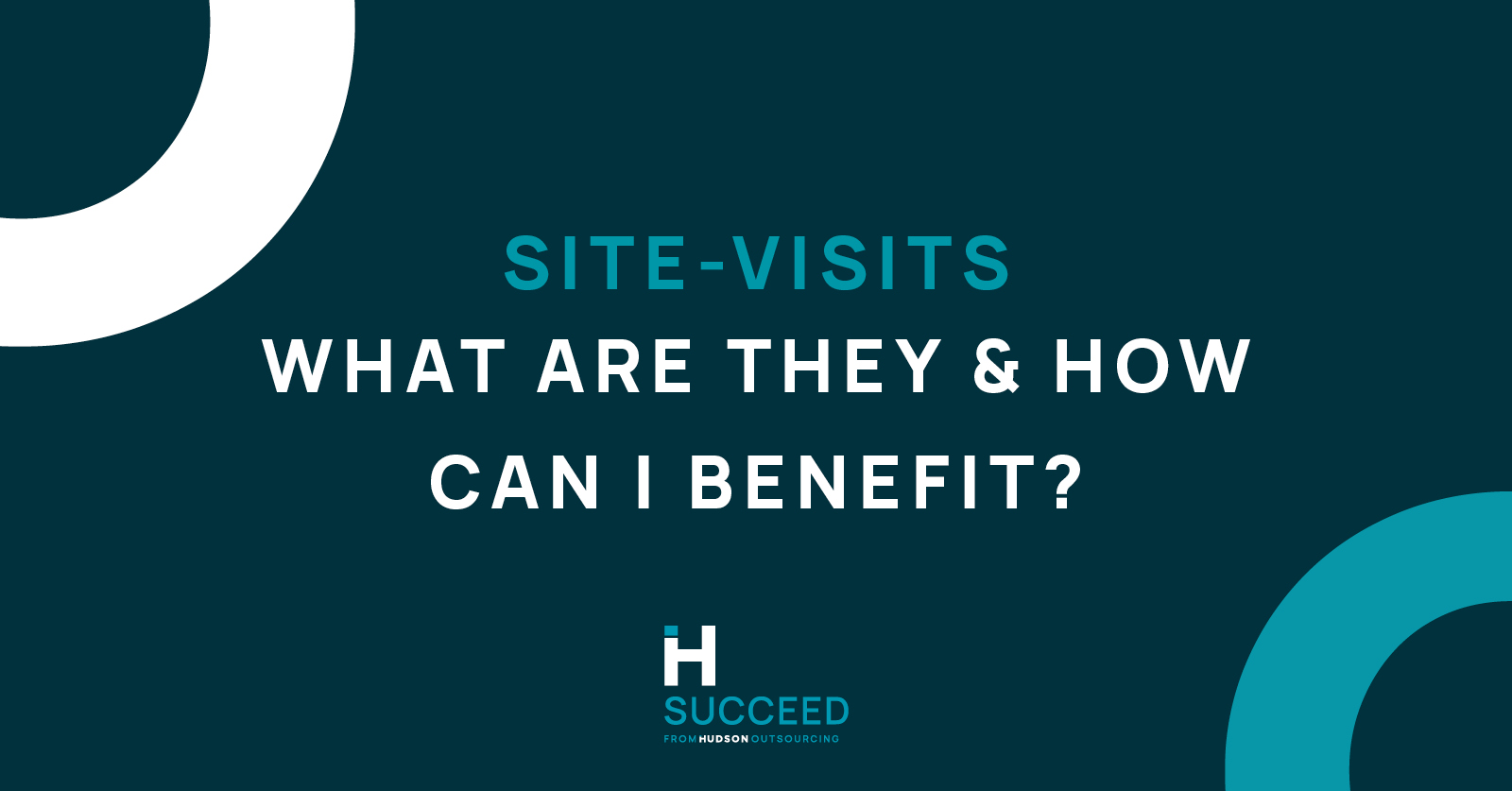
Site Visits – What Are They and How Can I Benefit?
30th january 2019.
Table of Contents
What is a Site Visit?
Last updated: Jun 7, 2022 @ 3:56 pm
Site visits are a component of the tendering process . They involve visiting the site where you are hoping to deploy your services, for the purposes of gaining in-depth information.
Are site visits common?
Within certain sectors, yes. Site Visits are not a universal aspect of tendering. You may find on one tender that it is compulsory to attend a site visit, for another that it is optional and for another, it is not offered as a possibility. This is yet another reason for reading the tender documents thoroughly. Not all tender documents are laid out in the same way. The information pertaining to potential site visits could be buried in an unlikely section of your documents.
Why do we need site visits?
Depending on the sector that you are tendering within, site visits may or may not be integral. If you work in Construction , Energy, Facilities Management or similar, then site visits are incredibly important for the following reasons:
Information gains
- Site visits pose a valuable source of information that you may not get from the tender documents .
- They present an opportunity to get detailed information from people who are knowledgeable about the site.
Accurate pricing
- If you are required to submit a pricing document, site visits give you the chance to gain meaningful information that you would never be able to glean from just the tender documents or internet searches. This will allow you to produce a realistic pricing strategy , preventing you from erroneously pricing too high or too low.
Better quality responses
- Site visits are invaluable for gathering details that will strengthen your quality responses, especially those that focus on Health & Safety, Contract Implementation and Risk Assessment & Mitigation.
- You can clarify any doubts that you may have about the information provided in the tender documents. This will again help you in your journey towards the completion of a detailed, competitive tender submission .
Site visit outcomes
There are several things that can happen as a result of a successful Site Visit.
- You could simply come away with more information to include in your tender submission , which is always a fantastic result.
- You may find that the tender deadline is extended if enough doubts, queries or clarifications are raised during the visit that causes the Buyer to consider releasing updated tender information.
How do I make the most out of my site visit?
Fortune favours the prepared. Before you go on your site visit, make sure you have covered the following points:
- Know as much about the Buyer as you can before you go. This will mean that you don’t waste valuable time asking questions that you could already know the answers to.
- Make a list of all the information you need to learn and take it with you. You might be confident that you have enough information about H&S requirements, but that you need a lot more information to help with pricing.
- Be confident and ask questions, even if you think the answer is probably obvious. Showing engagement throughout the site visit will stand you in good stead if you end up making it through to a Presentation Stage.
- Look for visual clues. You will be able to tell a lot about the Buyer and their work culture, especially regarding everyday H&S matters. This information could help you write a tender that emphasises areas you realised are more important to the buyer than others.
In conclusion
If you are hoping to supply a service that is deployed on a buyer’s site, then site visits are an unmissable opportunity to gain detailed, relevant information that could give your tender the defining edge. Don’t see them as an exercise in futility, but an opportunity to gain the upper hand over your fellow tenderers. If you ask smart questions, pay attention to the environment and embed as much of the information gained into your submission as possible, you will find that the quality of your tender submissions can grow exponentially. Partaking in a site visit can help you write a winning bid when tendering for contracts .
For more information or help with tender writing , please contact our Bid Writers and bid management consultants.
To find tender opportunities in your industry see our sector-specific tendering portals HERE .
Are you looking to learn more about tendering and procurement? See Tender VLE for our free, online, masterclasses.
Find more helpful tips and advice in our blogs. We cover topics including:
- How to win a tender
- The tendering process
- Writing winning bids
- 7 tips for tendering for contracts
- Tips for bid management
- Bid writing services
- The types of tendering procedures
- Writing bids
- Bid writing consultants
- Submitting a tender response
- And many more .
Share This Insight
Contact a bid writer.
- Hudson Secure Another Tender! Rawi Care UK
- Hudson Secure Another Tender! Recruit 4 Care Ltd
- Hudson Secure Another Tender! – Frontline Healthcare Professionals Ltd
- Hudson Secure Another Tender! – Agape Medical Health Care Ltd
- Hudson Secure Another Tender! – West Wales Action for Mental Health
Tendering Process for Technology Contracts
Win tenders in the hospitality sector: laundry, catering and more, tender vle: our virtual bid learning environment, how to win healthcare tenders: our 10 top tips, how to become a tender expert, top 10 tendering secrets.
- Easy Tendering Mistakes and How to Avoid Them
- Tendering in the Creative Sector
- Public Sector Frameworks: Everything You Need to Know Before You Apply
- Bid Writing Specialists
- Legal Services Tenders
- Tender Compliance: What does it mean to be non-compliant?
- The Do’s and Don’ts of Tendering
- Tender Management: Definition, Good Practice and Our Services
- National Lottery Bids
- Tendering Process in Construction
- Professional Tender Writers
- Public Sector Contracts
- Tendering: definition and how it works
- Top 10 Bid Writing Skills
- ITT meaning and how it works
- How to get a bid consultant?
- CPV: meaning, how it works and examples
- Capture Management – Top 4 Advantages of Capture Management
- Bid Writing North East
- How to Secure Government Contracts Without a Huge Bid Team
- How to Become a Government Supplier in the UK
- Win more contracts with a tender consultant
- Received a PIR CQC invitation? 5 things you should know
- What to expect from tender specifications
- Strategic Bid Management: Everything You NEED to Know to Succeed!
- 3 Benefits of Bid Management Companies You NEED to Know
- 8 Tips for Submitting Electronic Tenders
- Bid and Tender Writing Services: The Secrets to Success!
- How to Win Contracts: 7 Secrets You NEED to Know
Similar Insights

Tendering Process for Technology Contracts Winning technology contracts relies on a combination of experience in…

Win Tenders in the Hospitality Sector: Laundry, Catering and more! Winning hospitality tenders relies on…

Tender VLE It’s simple — to win contracts, you must have the necessary skills of…

How to Win Healthcare Tenders: Our 10 Top Tips! Winning healthcare tenders is a skill…

How to Become a Tender Expert Becoming a tender expert is a surefire way to…

Top 10 Tendering Secrets It is no secret that the tendering process can be complex…

Let’s get started.
Call for a FREE consultation with our Tender Writing Consultants or simply send us an email and a team member will contact you.
Request a Callback
- Tendering Opportunities
- Bid Resources
Privacy Overview
Site Visit vs. Differing Site Conditions
INTRODUCTION
This article is in all probability one of the most important ever generated by Excell because the issues of Order of Precedence, Site Visit Responsibilities, and Differing Site Conditions, have just been ruled on in a most favorable light by the United States Court of Appeals for the Federal Circuit dated February 11, 2014 . There is not a reader that cannot make money by reading this case, which is included as an attachment to this document.
Excell elected to address this subject matter because the combination of Site Visits and Differing Site Conditions provisions is an area of mass confusion for all contractors dealing with the Government, be it Construction, Operation & Maintenance, or even IT efforts. Because of the importance of this case, please consider this to be a snapshot concerning this subject matter.
Therefore, the conditions present on a job site can be quite different than those anticipated or even described by an owner or owner’s representative. Contractors should always take advantage of any opportunity to visit and investigate site conditions prior to submitting a bid. A failure to perform a site visit when it was permitted will, in all probability, negate a Differing Site Conditions assessment. Differing site conditions are considered to be, as defined by Common Sense Construction Law:
“…a physical condition encountered in performing the work that was not visible and not known to exist at the time of bidding and that materially differs from the condition believed to exist at the time of pricing the contract. Often this condition could not have been discovered by a reasonable site investigation.”
The purpose of the “Differing Site Conditions” clause is to transfer unknown risks to the Government as provided under FAR 52.236-2. Id . In the majority of cases, the “risk” pertains to any of the physical conditions mentioned above that were not known to exist at the time of bid. It is important to note that if the access to the site is not adequate or restricted, this clause becomes extremely important to a contractor bidding in such an environment. However, the contractor must protect himself, by notifying the Government, prior to the bid, of the restricted access or problems encountered as a result of a failure to be able to adequately undertake the site visit. This can occur because of a variety of reasons: A closed facility that should have been open; A restricted area within a facility that could not be accessed; Grounds that could not be reviewed due to weather conditions; and/or matters of a similar nature.
TYPES OF DIFFERING SITE CONDITIONS
There are at least two (2) different types of differing site conditions. The first is a Type I which consists of “…subsurface or latent physical conditions that differ materially from those indicated in the contract documents” and Type II which consists of “…unusual physical conditions that differ materially from those ordinarily encountered in similar work.” Id . The main difference between the two different types is that Type I focuses on what is “indicated” in the contract documents or in the plans or specifications. Type II, on the other hand, focuses on what is “encountered” instead of what is indicated in the contract documents.
TYPES OF RECOVERY
Just as there are different types of differing site conditions, the recovery available for each different type is also varied. Type I differing site conditions require that the contractor “ prove ” the following items, remembering that the “burden of proof” lies with the bidder:
- The contractor relied upon the physical conditions indicated in the contract;
- The nature of the actual conditions encountered;
- The existence of a material variation between the conditions indicated and the conditions actually encountered;
- That notice, as required by the contract, was given; and
- The changed condition resulted in additional performance costs, time, or both, as demonstrated by satisfactory documentation or proof. Id.
Under FAR 52.236-2, the contractor is required to report, in writing and before the conditions are disturbed, to the Contracting Officer, the conditions on the site that differ from those indicated in the contract or those conditions that differ from what is usually encountered. NOTE: There are exceptions and a good Contract Professional will know them and be able to use them effectively when they occur. Ask yourself: Do you know the nuances? If not, you are losing money! This will require that the Contracting Officer investigate the site conditions and make any adjustments necessary based on the investigation. A contractor cannot make a request for equitable adjustment for differing site conditions if final payment has already been made. (See FAR 52.236-2 (a-d)) It is important to note that items such as test samples, borings, unsuitable excavation materials to be used for fill and any limitations on a contractor’s access to the site, if properly referenced or incorporated as part of the contract documents, can be included as “indications” for purposes of recovery in Type I Differing Site Conditions. Type II differing site conditions recovery can include simply showing that the conditions are “unknown and unusual.” Id . The primary factor is the conditions encountered are compared to what is expected to be encountered. Items such as buried pipe or construction debris, utilities, or soil conditions that were not expected are considered Type II differing site conditions that could logically not be expected to occur on a particular job site. This case has comprehensive application: practically every problem encountered concerning a Differing Site Condition is addressed in this February 2014 case. It also addresses the areas of risk, the Government responsibility concerning risk, and the new treatment of the risk based upon this case – all dramatically in favor of the contractor. This case starts out with an expansive soils issue, touches on notice requirements, and damages by the Government due to its failure to properly recognize the change to the contract and the delays occasioned by its inactions. This is mandatory reading in Excell’s opinion. Excell believes there is real money buried in this case for all contractors to be aware of; not just construction contractors. It is basically new law supported by the overturning of prior cases.
Differing Site Conditions under FAR 52.236-2 are outlined specifically so that contractors can be aware of what is required of them to report any site conditions that are different from what was expected or otherwise “indicated”. As found in Metcalf (above) , the incorporation of FAR 52.236-2 is intended to “…take at least some of the gamble on subsurface conditions out of bidding.” Id . Contractors should educate themselves about all of the terms and conditions included in Government contracts and any other rules or guidelines that are in place. Thus, retaining the assistance of a professional consultant should be seriously considered to protect a contractor’s interests properly and thoroughly. The experts at Excell Consulting International, Inc. have experience with the Differing Site Conditions clause and stand ready to assist and evaluate your company’s position and provide valuable and cost-effective guidance for your business.
In the end, you will be glad you made the call; by the way, it’s FREE.
EXCELL CONSULTING “HERE TODAY FOR YOUR TOMORROW”
Author’s note: The information contained in this article is for general informational purposes only. This information does not constitute legal advice, is not intended to constitute legal advice, nor should it be relied upon as legal advice for your specific factual pattern or situation. – John G. Balch, CEO CPCM For a printable pdf copy of this article click here .
Privacy Overview
Page Views vs. Visits: What's The Difference? We Break It Down
Published: December 29, 2021
When it comes to your website reporting, it’s important to know exactly what you’re tracking and what the metric means.

If you’re using HubSpot’s Marketing Analytics tool , you may have noticed the following metrics in your dashboard: page views, page visits, page sessions. So what’s the difference between these three? Let’s dive in.
Understanding Page Views vs. Visits
A page view occurs when a page on your website is loaded or reloaded whether the user was already on your page or came from an external page. A page visit, on the other hand, only occurs when someone lands on your site from an external page, such as Google or another website.
So technically, every page visit is a page view, but the same is not true the other way around.
It’s important to know this difference, as it can greatly impact your understanding of audience behavior and page performance.
Without this knowledge, you might think that high page views is an indicator of a high-performing website but that’s not always the case. You’ll need to look at more metrics, like page sessions, unique page views, page visits, and other metrics to get a full picture.
Now that we broke that down, we’re going to further explain each metric in detail. Before we get there, it’s important to understand what a session is, as that can help your understanding of other website metrics.
What is a session?
A session is a measurement of visitor engagement that groups together analytics activities taken by a single visitor on your website. It expires after 30 minutes of inactivity.
It works by grouping together the actions taken by visitors as they navigate through your site. This includes the pages they are viewing, the elements they engage with (Think CTAs, forms, or events.)
The time-sensitive element of a session allows you to drill into engagement and traffic on your site.
Here’s an example: A visitor lands on your website’s homepage by clicking on a link from a blog post. They spend some time scrolling down the page, navigating to your product page, and even reading your "About Us" page. Then, they decide to leave the website.
Ten minutes later, the same visitor is still thinking about your product and decides to return directly to your pricing page. All of these actions would count as one session.
Even though the visitor completely left your site, they have not been inactive for more than 30 minutes, so the second visit to your website is recorded as a continuation of their original engagement to your site. If the visitor chose to return after that session has elapsed, their visit would kick off a new session.
How to Understand the Page Views of a Website
A page view is when a page on your site is loaded by a browser.

Don't forget to share this post!
Related articles.

How to Effectively Run an A/B Test On Your Landing Pages

4 Best Practices For Effective Landing Pages in 2015
![site visits definition Personalize Your Simple Follow-up Emails [Product Update]](https://blog.hubspot.com/hs-fs/hub/53/file-411136170-png/academy/images/new_lps_available.png)
Personalize Your Simple Follow-up Emails [Product Update]

Why You Need A Blog Subscription Landing Page

Why Landing Page Optimization is so Important
Calls to Action and Landing Pages [Concept of the Week]

3 Secrets of the Top HubSpot Customer Landing Pages
![site visits definition Place Your Landing Page Content Above the Fold [Google Tool]](https://blog.hubspot.com/hs-fs/hub/53/file-405636074-jpg/academy/images/place-your-content-above-the-fold.jpg)
Place Your Landing Page Content Above the Fold [Google Tool]

Better Landing Pages Start With a Marketing Persona

Top 5 Landing Page Mistakes
Outline your company's marketing strategy in one simple, coherent plan.
Marketing software that helps you drive revenue, save time and resources, and measure and optimize your investments — all on one easy-to-use platform
Visits, visitors, unique visitors… what are the differences for the web analyst?

Today’s Web analytics solutions offer a multitude of measurement tools with comprehensive analysis options. Identified Visitors, Unique Visitors, Visitors, Visits , Viewed Pages or downloads are only a small part of it. At first glance, these standard measures seem very similar or even interchangeable, but they all say something different. To help you see more clearly, this article briefly presents the most important standard metrics and their meaning in AT Internet’ s Analytics Suite .
Visitors / Unique visitors / Identified visitors:
The term “ visitor” refers to a user who visits a website . However, a visitor is not considered as a single person but as a browser or a terminal . For example, a single user can access a website via different browsers (such as Google Chrome, Firefox or Microsoft Edge), different computers (at work and at home) or different terminals (smartphone and laptop).
If a visitor visits a page once in the morning and once in the evening, this user is counted as a single visitor with two visits. This same user will be considered a different visitor if they return to the site the next day. If we want a visitor who returns on another day to be counted only once, we must look at the metric unique visitors.
Unique visitor
The measurement of unique visitors is based on cookies . A cookie is a file placed on a browser that contains an anonymous identifier. This ID can be used to uniquely identify a browser.
As a result of this measurement method (which is the basis of all current analytical systems), inaccuracies may occur. For example, a browser may refuse to accept cookies, or a user may decide to delete them.
In most cases, however, a terminal has a cookie and is included in the calculation of unique visitors.
In the Analytics Suite , we distinguish between unique visitors who accept cookies and unique visitors who do not accept cookies. The latter category of visitors can be determined over a one-day period using the fingerprint method. The total number of unique visitors is therefore the sum of these two types of unique visitors.
In AT Internet’s Analytics Suite , you will find the analysis of unique visitors in the User Insights section. You can evaluate the frequency of visits, the retention rate or the terminals used.

Unique visitors are identical to visitors on a daily basis (Day 1: Unique visitors = Visitors = 3). If we now consider a period of several days, we obtain 8 Visitors (3+1+2+2+2+2, the Day Visitors are added together), and 3 Unique Visitors (deduplicated).
In the Analytics Suite , unique visitors can also be analysed on multiple websites (level 1).
Identified visitor
Identified visitors are measured using a unique identifier that is sent in the tagging when connecting to an authenticated space (login + password) and are common to all platforms (computer, tablets, smartphones…). It is this unique identifier that allows the cross-device analyses available in the User Insights module of the Analytics Suite.
Identified visitors should therefore not be considered as unique visitors. A unique identification of a unique user on different devices and browsers is only possible if the user actively identifies themselves. This is possible through a connection and can then be analysed using the “Identified Visitor” metric.
Visits, page views
A visit is defined as a visit to a website where at least one page has been loaded. Visits indicate a continuous process of using a website and should not be confused with the number of visitors, as a visitor may make several visits to the same site.
It should be noted, however, that the period during which each visit is counted only once may vary considerably.
AT Internet calculates this metric in this way: if a visitor does not perform a new action within 30 minutes, a visit is considered complete. The number of visits to a website is expressed in relation to a specific period (day, week, month…).
The visit is fundamental for the preparation of most analyses. The visit provides you with information on navigation (initial page, content viewed, exit page) and behaviour (duration, loads/page views, bounce rate, etc.).
This illustration shows two visits on five pages with all the associated information:
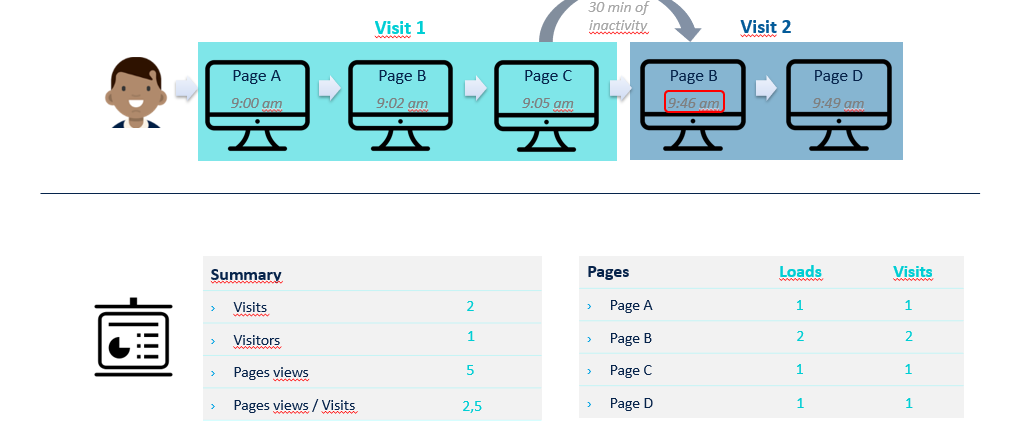
There are different types of visits:
- Total number of visits: Total number of visits in a given period
- Incoming visits: Visits with at least two pages viewed
- Bounce visits: visits with only one page viewed
The Analytics Suite can also evaluate visits without page loading, for example if a user has only seen one advertising element.
Limits of the “Visit” metric.
Imagine that a user visits and then leaves a website by turning off his computer or changing sites. 20 minutes later, he returns to the first site: he will always be considered to be in the same visit, which means that only one visit will be counted. On the other hand, if a visitor accesses a website through Microsoft Edge and returns to the site via Firefox 10 minutes later, two visits will be counted because the user will not be identified as the same visitor (the cookie varies from one browser to another).
A visit is not automatically closed when the browser is closed. In the field of digital analytics, it is unfortunately not possible to determine the exact time of exit from the site, because the user cannot send a specific message to the servers indicating that he has left the site.
This problem affects all web analytics solutions. Thus, as suggested by the DAA (Digital Analytics Association), AT Internet terminates a visit after 30 minutes of inactivity but this duration can be configured according to the needs of the site. This happens regardless of whether the browser is locked.
In AT Internet’s Analytics Suite , only one source of traffic is assigned to a visit, which is unique and unchanging. This means that the first source of a visit or the initiator of the visit is valid for the entire duration of the visit.
A page view is the loading of a page from a website or application. Each page viewed generates a hit that is sent to AT Internet. Each of these occurrences increases the “page views” metric by 1. the following graph illustrates its operating principle:

1. The User requests to load a page on the Site’s host server.
2. This server returns the page content (images, texts, etc. and the JavaScript code of the Internet AT tag).
3. The JavaScript tag is executed on the online user’s computer and collects information.
4. The tag requests an image on the Internet AT server and transmits the collected information as parameters.
5. The Internet AT server returns the requested image (1 pixel x 1 pixel, transparent).
If two tags were placed on the same page, each load of that page would be counted twice.
In summary:
A visit is a user’s journey through the site or application. A visit contains one or more page views. As soon as a user is inactive for 30 minutes because he has left the site or remained on the same page, a visit is considered complete.
A visitor is a user of a website. If a visitor visits a page several times a day , with interruptions of more than 30 minutes, AT Internet considers him/her as a unique visitor who has generated several visits. If a visitor visits the website on two different days, he or she will be counted as two visitors. If the AT Internet cookie is deleted after each visit, this visitor is considered a new visitor for each new visit.
On a single day, unique visitors correspond to the definition of “normal” visitors. However, if you look at a period of more than one day, these values differ due to the recognition of cookies. If a visitor has a cookie on his browser and visits the site twice on different dates, this visitor will be recognised as a unique visitor and counted only once in the analysis period.
Pictured example: A visit to a website can be compared to a visit to a hotel: a guest (unique visitor) can be a guest of a hotel several times during a month (visitor) and can enter and leave the hotel several times during a stay (several visits). In the hotel, the guest will move to different rooms (page views).

Gross range:
Gross reach refers to the sum of contacts made by an advertising medium during a given period on a target group. It does not take into account the fact that some people may have been in contact with the media several times, since, unlike the net reach, each contact is counted. The raw scope therefore says nothing about the exact number of people affected.
The raw scope depends on the information to be determined. Here are some examples:
- Raw scope of a website > Number of Visits
- Gross reach of an advertising banner > Number of banner loads
- Gross scope of an article on a website > Number of pages viewed (or uploaded)
Net reach refers to the number of people that an advertising medium reaches at least once during a certain evaluation period. It is expressed as an absolute value or as a percentage of the population. While the gross reach counts all contacts, the net reach deducts double or multiple contacts to give only the “exact” number of people reached by a publication.
In our Analytics Suite , the net reach is the value of unique visitors .
More than just measures: key performance indicators (KPIs)
You now know some of the most important key indicators for web analytics. For more information, see our more detailed article on the metrics analysed in Analytics Suite 2.
Need advice on defining the most relevant metrics for your objectives? Thanks to our free downloadable guide, you will learn how to define and analyse the right KPI’s according to your digital strategy:

DA Blog Editorial Team AT Internet’s editorial team and a diverse group of blog contributors work together to bring you insightful articles about digital analytics. Have feedback for us, or ideas to share? Want to see more on a certain topic? Get in touch!
Related Posts

5 Steps for Launching a Data Project in Your Organisation

Data Sampling: Quality Over Quantity

AT Internet’s Data Health Checklist
Comments are closed.

- Implementation & Tagging
- Analytics Tips & Tools
- Mobile, Apps & Cross-Device
- Data Governance & Strategy
- Digital marketing
- Beyond Analytics
- Analytics Suite
- Happening @AT
- AT INTERNET.COM

View usage data for your SharePoint site
As a SharePoint in Microsoft 365 site owner, you can view information about how users interact with your site. For example, you can view the number of people who have visited the site, how many times people have visited the site, and a list of files that have received the most views.

Important:
Site admins, owners, members, and visitors can view site usage data.
Site visitors cannot run external user reports or download the 90-day usage report.
Some functionality is introduced gradually to organizations that have set up the targeted release options in Office 365 . This means that you may not yet see this feature, or it may look different than what is described in the help articles.
Lifetime stats are shown for sites created after February 2018. Sites created before this date will show stats from February 2018 forward.
Guest users with Site Owner permissions will not have access to site analytics or site usage data.
Guest and anonymous views and visits are included for sites after March 2019 and forward.
Site usage reports are only supported for Worldwide Production Environments and for some Special Cloud deployments of Microsoft 365. See below for details.
User activity reflected in the report will not include usage data collected in the last 60 minutes.
What's on the site usage page
All reports on the site usage page exclude some file extensions, except for the Shared with external users report. Details about the list of extensions that are excluded from each report is shown at the bottom of the page.
To view the names of the individuals who have accessed your site, your SharePoint administrator will need to activate the SharePoint Viewers setting.
When the SharePoint Viewers setting is enabled, individual names will be seen in the library hover card, not on the Site Usage page.
Usage data for Unique viewers, Site visits, and Average time spent per user is aggregated and displayed based on Coordinated Universal Time (UTC).
Unique viewers
Shows the total number of individual visitors to the site, regardless of how often they've visited. Usage data accounts for user activity for site content such as pages, documents, and news, including 'news for email' inbox viewers. This data is presented using the Coordinated Universal Time (UTC).
You can review daily unique viewer trends on your site for the last 7 days, last 30 days, and last 90 days. The overall unique viewer count is available for the last 7 days and the last 30 days.
In the example below, the 7 day view for this site tells us there have been 168 unique views which is a 30% increase in traffic from last week. On the right-hand side of the graph, you'll see the lifetime unique viewers which is the total number of people who viewed content on this site since February 2018 and in this example is 3,468.
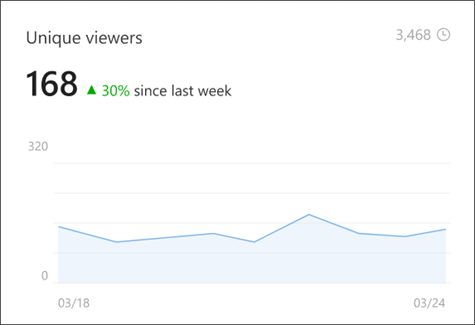
Site visits
Shows the total number of visits to content on this site for the last 7 days, last 30 days, and last 90 days. Site content includes pages, documents, and news, including 'news for email' inbox views. This data is presented using the Coordinated Universal Time (UTC).
The algorithm used to calculate Site visits is designed to filter out repetitive, continual operations by the same user on the same item (page, document, or news). For example when a user repeatedly refreshes a page, document, or news post.
In the example below, the 7 day view for this site tells us there have been 567 site visits which is a 10% decrease in traffic from last week. On the right hand side of the graph, you'll see the lifetime site visits which is the total number of people who viewed content on this site since February 2018 and in this example is 125,498.
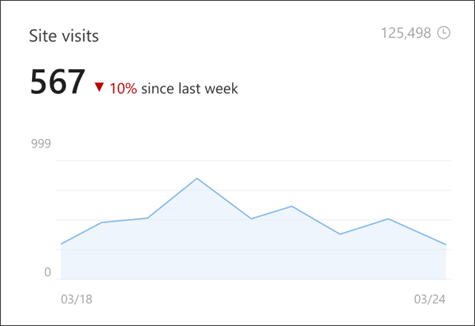
Average time spent per user
Note: A small amount of traffic will not be accounted for in this report due to web browser restrictions.
Shows the trend of actual time spent on modern SharePoint site pages and news posts by users. The report calculates the time when users are actually active on the page or news post, not counting the time when the page is minimized or when the user has the page open but is inactive. The average metric for 7 and 30-day period is calculated by measuring the total time spent on that page and the number of the unique visitors on that page in the given timeframe. This data is presented using the Coordinated Universal Time (UTC).
This report currently does not provide the average value for 90-day period and does not support lists, documents, administrative pages (such as the site usage or site permissions page), or News for Email inbox views. Usage on mobile app is currently not incorporated in calculation of this report.
In the example below, the 7 day view for this site tells us average user spends 6 minutes and 45 seconds actively engaged with your site which is a 40% decrease from last week. There is no lifetime average time spent per user metric.
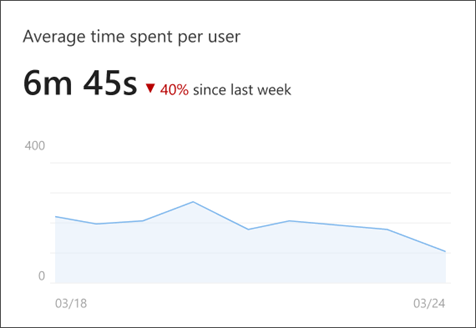
Popular content
Shows the most popular content on the site sorted by site pages, news posts, and documents. Popular content can be sorted by unique viewers, total views, or time spent for site pages and news posts. This report is available for the last 7 days.
For popular documents, sorting is available by unique viewers or total views .
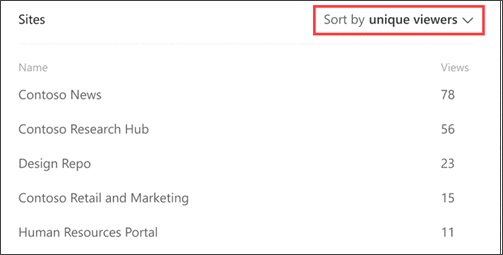
Site traffic
Shows the hourly trend of visits to the site over the last 7 days, last 30 days, and last 90 days for the viewer's local time zone . Darker shades on the chart refer to time slots when there are more views on the content in the site. Use this map to determine to best time to post news and big announcements.
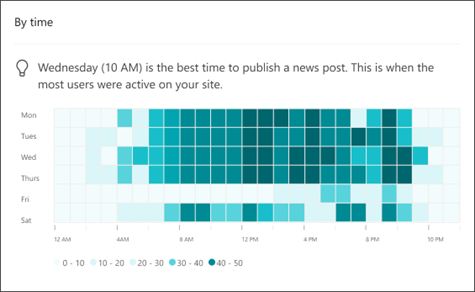
Popular Platforms
Shows the distribution of visits to the sites' content organized by the platform (desktop, mobile web, mobile app, tablet. This data is available for the last 7 days, last 30 days, and last 90 days.
This report is generated based on "user agent" headers which are part of the received metadata when a user visits any site content.
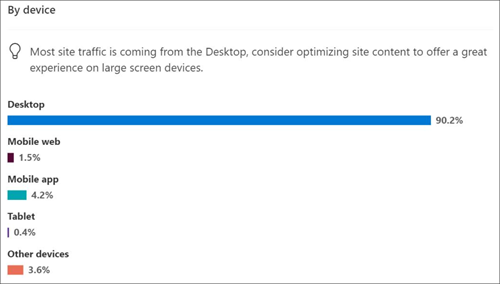
Export site usage data in excel file
Site owners can export the 90-days site usage data in an excel file by going to the download button on site usage page. Select the button to download 90-days data for unique viewers, site visits, popular platforms and site traffic. For popular content on the site (news posts, documents and pages) the report will be for last 7 days.
To export a site usage report, select the download icon near the right hand corner of the page:

The site usage report download does not include data for Shared with external users in the report.
The site usage report download does not include data for average time spent per user .
To export a Shared with external users report, you need to extract this data to a CSV file by clicking the Run Report button on the bottom right corner of the page. You cannot select a time period and data includes the attributes: Resource Path, Item Type, Permission, User name, User Email, User or Group Type, Link ID, Link Type, AccessViaLinkID.
Shared with external users
List of files that you have access to that are shared with users outside your organization through a sharing link that requires them to log in before they can view the file.
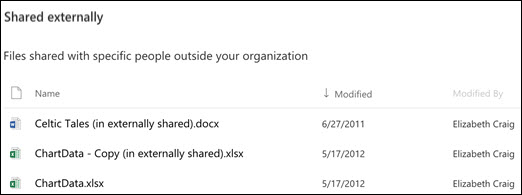
Usage reports for SharePoint hub sites
Hub usage page metrics for Popular content will vary depending on the viewers permission level. However, the aggregated report for Unique viewers and Hub visits will reflect metrics for the entire hub regardless of viewer permission.
Hub analytics reports support analytics for up to 200 sites in the hub. If your hub contains more than 200 associated sites, then you will only be able to data for the top 200, most recently used sites in this report.
The "Unique Viewers" and "Hub Visits" reports on the page show aggregated usage data for all sites in the hub for the last 7 and 30 days. The "Popular content" report shows the top pages, news posts and documents across all associated sites in the hub in the last 7 days. Find out which sites are most popular in the hub by seeing the "Sites" section within the Popular content report.
To analyze usage data for only the hub site (without aggregating data from the associated sites), you can use the drop-down on the top-right of the page to switch to seeing data for the hub site only.
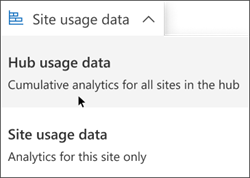
Usage reports for special cloud deployments of M365
Your organization's SharePoint tenant may not include all of the site usage reporting functionality depending on special cloud deployments scenarios for M365. Ask your M365 administrator which type of special cloud deployment your organization uses to understand what site analytics report data is available to you.
Permissions

Excluded File-Types
The following file-types are currently excluded from all reports on Site and Hub Usage ( except "Shared with external users" report ):
jpg, png, js, css, gif, jpg5_1, jpeg, one, onepkg, onetoc2, spcolor, sptheme, spfont, eot, ico, onebin, svg, woff, woff2, xsl
Monitoring usage data for apps
Monitor apps for your SharePoint Online environment describes how to monitor apps from the Admin dashboard. From the Microsoft 365 home page, click Admin center, and then click Usage . You can explore usage of email, files, OneDrive, and more.
Exporting the 'Shared with external users' report
The Shared with external users report can now be exported for further analysis and reporting. Site Owners and admins can extract this data to a CSV file by clicking the Run Report button on the bottom right corner of the page. You cannot select a time period and data includes the attributes: Resource Path, Item Type, Permission, User Name, User Email, User Or Group Type, Link ID, Link Type, AccessViaLinkID.
Get usage analytics for a SharePoint page or news post
With page analytics , you can view information about how users interact with your page or news post. For example, you can view the number of people who have viewed the page over periods of time, average time spent on the page spent per user, and page traffic by time.

Need more help?
Want more options.
Explore subscription benefits, browse training courses, learn how to secure your device, and more.

Microsoft 365 subscription benefits

Microsoft 365 training

Microsoft security

Accessibility center
Communities help you ask and answer questions, give feedback, and hear from experts with rich knowledge.

Ask the Microsoft Community

Microsoft Tech Community

Windows Insiders
Microsoft 365 Insiders
Was this information helpful?
Thank you for your feedback.
- More from M-W
- To save this word, you'll need to log in. Log In
Definition of visit
(Entry 1 of 2)
transitive verb
intransitive verb
Definition of visit (Entry 2 of 2)
- call (on or upon)
- drop in (on)
Examples of visit in a Sentence
These examples are programmatically compiled from various online sources to illustrate current usage of the word 'visit.' Any opinions expressed in the examples do not represent those of Merriam-Webster or its editors. Send us feedback about these examples.
Word History
Middle English, from Anglo-French visiter , from Latin visitare , frequentative of visere to go to see, frequentative of vidēre to see
13th century, in the meaning defined at transitive sense 3d
1621, in the meaning defined at sense 1a
Phrases Containing visit
- conjugal visit
- pay a visit to
- pay (someone) a visit
- visit on / upon
Dictionary Entries Near visit
vision quest
Cite this Entry
“Visit.” Merriam-Webster.com Dictionary , Merriam-Webster, https://www.merriam-webster.com/dictionary/visit. Accessed 28 Apr. 2024.
Kids Definition
Kids definition of visit.
Kids Definition of visit (Entry 2 of 2)
Middle English visiten "to go to a person especially to give comfort," from early French visiter (same meaning), derived from Latin visere "to go to see," from vidēre "to see" — related to vision
Medical Definition
Medical definition of visit.
Medical Definition of visit (Entry 2 of 2)
More from Merriam-Webster on visit
Nglish: Translation of visit for Spanish Speakers
Britannica English: Translation of visit for Arabic Speakers
Subscribe to America's largest dictionary and get thousands more definitions and advanced search—ad free!

Can you solve 4 words at once?
Word of the day.
See Definitions and Examples »
Get Word of the Day daily email!
Popular in Grammar & Usage
More commonly misspelled words, commonly misspelled words, how to use em dashes (—), en dashes (–) , and hyphens (-), absent letters that are heard anyway, how to use accents and diacritical marks, popular in wordplay, the words of the week - apr. 26, 9 superb owl words, 'gaslighting,' 'woke,' 'democracy,' and other top lookups, 10 words for lesser-known games and sports, your favorite band is in the dictionary, games & quizzes.

CREATED FOR:
The ‘Visits’ metric shows the number of sessions across all visitors on your site.
How this metric is calculated
A visit always ties to a time period, so you know whether to count a new visit if the same person returns to your site. A visit starts when the user first arrives on your site. A visit ends when they meet any of the following criteria:
- 30 minutes of inactivity : Almost all sessions end in this manner. If more than 30 minutes lapse between hits, a new visit begins.
- 12 hours of activity : If a user consistently fires image requests without any 30-minute gaps for more than 12 hours, a new visit automatically starts.
- 2500 hits : If a user generates a large number of hits without starting a new session, a new visit is counted after 2500 image requests.
- 100 hits in 100 seconds : If a visit has more than 100 hits that occur in the first 100 seconds of the visit, the visit automatically ends. This behavior typically indicates bot activity, and this limitation is enforced to help increase report performance.
A visit does not necessarily coincide with a browser session because of the above criteria. One of the most common differences is where a visitor navigates to your site, leaves the tab open for more than 30 minutes, then resumes browsing. While this action is technically part of the same browsing session, Adobe considers this action two separate visits.
Behavior that affects visits
If a visitor performs any of these actions, a new visit starts:
- Clears their cache mid-session and continues browsing your site
- Leaves your site open in a tab for longer than 30 minutes, then continues browsing
- Opens a different browser and navigates to your site on the same computer
- The same person browsing your site on different devices
If a visitor performs any of these actions, a new visit does not start as long as there is less than 30 minutes between consecutive hits:
- Closes their browser, then navigates to your site again
- Restarts their computer, opens the same browser, and navigates to your site again
- Transitions to a different network, such as disconnecting from a wired network docking station to a wireless network
- Browses your site in multiple tabs. If a visitor switches back and forth between tabs, each hit counts as part of the same visit.
Change the definition of a visit
You can change the definition of a visit to a time other than 30 minutes.
- For Virtual report suites , you can change the visit timeout using the Visit timeout drop-down list. You can change visit timeout to any reasonable value.
- For standard report suites, contact Customer Care to request visit length be shortened for a given report suite. Visit length for standard report suites cannot exceed 30 minutes, so you can only shorten it.
Visits that span a date boundary
A visit counts for each time period involved. For example, if you have a visitor that starts navigating your site on Monday at 11:45 PM, then sends their last image request on Tuesday at 12:10 AM, you would see a visit attributed to both Monday and Tuesday. However, the total visit metric is deduplicated, showing a single visit for the project date range.
Visits on a dimension versus total visits
Visits in context of a dimension (for example, Marketing channel ) show the number of visits that contained a particular dimension item at any time. Multiple dimension items frequently exist on different hits in the same visit. Attempting to sum visits that report on dimension items usually does not make sense.
Visits All Visitors in Data Warehouse
The metric ‘Visits - All Visitors’ is available in Data Warehouse in addition to the ‘Visits’ metric. The ‘Visits - All Visitors’ metric is comparable to the ‘Visits’ metric in other Analytics tools. The ‘Visits’ metric in Data Warehouse excludes visitors that don’t have persistent cookies. Adobe recommends using ‘Visits - All Visitors’ in Data Warehouse requests where visits are desired as a metric.
Your session is about to expire
Site initiation visit (siv): clinical trial basics, what is an siv in clinical research, siv definition: site initiation visit.
An SIV (clinical trial site initiation visit) is a preliminary inspection of the trial site by the sponsor before the enrollment and screening process begins at that site. It is generally conducted by a monitor or clinical research associate (CRA), who reviews all aspects of the trial with the site staff, including going through protocol documents and conducting any necessary staff training.[ 1 ],[ 2 ]
Also known as a study start-up visit, the sponsor can only request an SIV after the site has been selected and formal agreements such as the CTA have been signed.
What is the purpose of an SIV?
Clinical trial SIVs are necessary to ensure that all personnel of a given site who will be involved in the clinical trial, such as investigators and study staff, thoroughly understand the trial protocol and are trained appropriately so as to handle their role and responsibilities. Furthermore, the site initiation visit has the aim of ensuring the trial site is operationally ready, with working infrastructure, tools, and any study materials needed.[ 1 ]
Given the scope of the SIV, clinical trial sponsors should schedule this visit well before enrollment so that there is plenty of time to comprehensively inspect all relevant processes, and to conduct further training or rectify any issues, if necessary.
Can the SIV be conducted before IRB approval?
IRB approval is generally necessary before the SIV is carried out. Clinical trial sponsors should select sites that are compliant with all applicable regulatory requirements, and after the site receives IRB approval for the research, the sponsor can conduct the SIV.
SIV checklist for thorough site initiation visits
Given the importance of the SIV, clinical trial sponsors should make the most of this inspection visit by coming fully prepared with a detailed checklist of what is to be confirmed during the SIV.
Clinical trial sites might receive a copy of this checklist so they can ensure that all relevant staff are present for the visit. Specific tasks to include in the SIV checklist include the following:[ 1 ],[ 2 ],[ 3 ],[ 4 ]
- Discussing the clinical trial’s objectives with study staff
- Educating the research team on Good Clinical Practices
- Reviewing the operation schedule for the protocol
- Discussing the enrollment and screening process, including clarifying the inclusion and exclusion criteria
- Reviewing the informed consent documents and procedure
- Clarifying procedures for storing, dispensing, and managing the investigational product (IP)
- Checking inventory for all required medical supplies and equipment
- Ensuring secure access to all digital platforms, i.e., correct usernames and passwords
- Touring the clinical trial site to ensure facilities are in proper condition
- Reviewing and discussing all clinical trial documentation, such as forms, surveys, SOPs, etc.
- Reviewing the data management system and any other technological solutions forming part of the site’s or sponsor’s workflow
- Ensuring that site staff are up to date on training and understand how to maintain essential documentation
- Reviewing the site/trial budget financial protocols, including any processes related to compensating trial participants
- Verifying and testing reporting procedures possible adverse events
- Leaving room for an open discussion of any specific concerns that trial staff may have
This checklist provides basic guidelines only, and should be built upon and customized for each individual study according to risk areas and specific protocols.
Other Trials to Consider
Family-based mental health navigation
Auditory alone brief relaxation, active portable air cleaner (pac), virtual poc toxicology test, intraoperative incisional wound irrigation with povidone-iodine solution, traditional, social needs navigator program, popular categories.
Colon Cancer Clinical Trials 2024
Cannabis Clinical Trials 2024
Prostate Clinical Trials 2024
Zika Virus Clinical Trials 2024
Paid Clinical Trials in Milwaukee, WI
Ofev Clinical Trials
Smoking Cessation Clinical Trials 2024
Scleroderma Clinical Trials
Semantic Dementia Clinical Trials 2023
Craniopharyngioma Clinical Trials 2023
Popular guides.
- Cambridge Dictionary +Plus
Meaning of visit in English
Your browser doesn't support HTML5 audio
- I want to buy a little something to give to Val when I visit her in hospital .
- There are several places of interest to visit in the area .
- I've never been to Kenya, but I hope to visit it next year .
- I have clear memories of visiting my grandfather's farm as a child .
- He picked up malaria when he was visiting the country on business .
- beard the lion (in his/her den) idiom
- call (in) on someone
- happen along/by (somewhere)
- have access to someone/something
- state visit
- stomping ground
- stop by (somewhere)
You can also find related words, phrases, and synonyms in the topics:
Phrasal verbs
- They received a visit from the police .
- My uncle paid us a surprise visit yesterday .
- He gave a talk about his visit to America .
- The timetable for our trip to Paris includes visits to Notre Dame , the Eiffel Tower and the Louvre.
- The president's official visit marks the start of a more relaxed relationship between the two countries .
visit | American Dictionary
Examples of visit, collocations with visit.
These are words often used in combination with visit .
Click on a collocation to see more examples of it.
Translations of visit
Get a quick, free translation!

Word of the Day
doggie day care
a place where owners can leave their dogs when they are at work or away from home in the daytime, or the care the dogs receive when they are there

Dead ringers and peas in pods (Talking about similarities, Part 2)

Learn more with +Plus
- Recent and Recommended {{#preferredDictionaries}} {{name}} {{/preferredDictionaries}}
- Definitions Clear explanations of natural written and spoken English English Learner’s Dictionary Essential British English Essential American English
- Grammar and thesaurus Usage explanations of natural written and spoken English Grammar Thesaurus
- Pronunciation British and American pronunciations with audio English Pronunciation
- English–Chinese (Simplified) Chinese (Simplified)–English
- English–Chinese (Traditional) Chinese (Traditional)–English
- English–Dutch Dutch–English
- English–French French–English
- English–German German–English
- English–Indonesian Indonesian–English
- English–Italian Italian–English
- English–Japanese Japanese–English
- English–Norwegian Norwegian–English
- English–Polish Polish–English
- English–Portuguese Portuguese–English
- English–Spanish Spanish–English
- English–Swedish Swedish–English
- Dictionary +Plus Word Lists
- pay a visit
- Collocations
- Translations
- All translations
Add visit to one of your lists below, or create a new one.
{{message}}
Something went wrong.
There was a problem sending your report.

The Art of the Customer Visit: How to Plan One + Why You Should
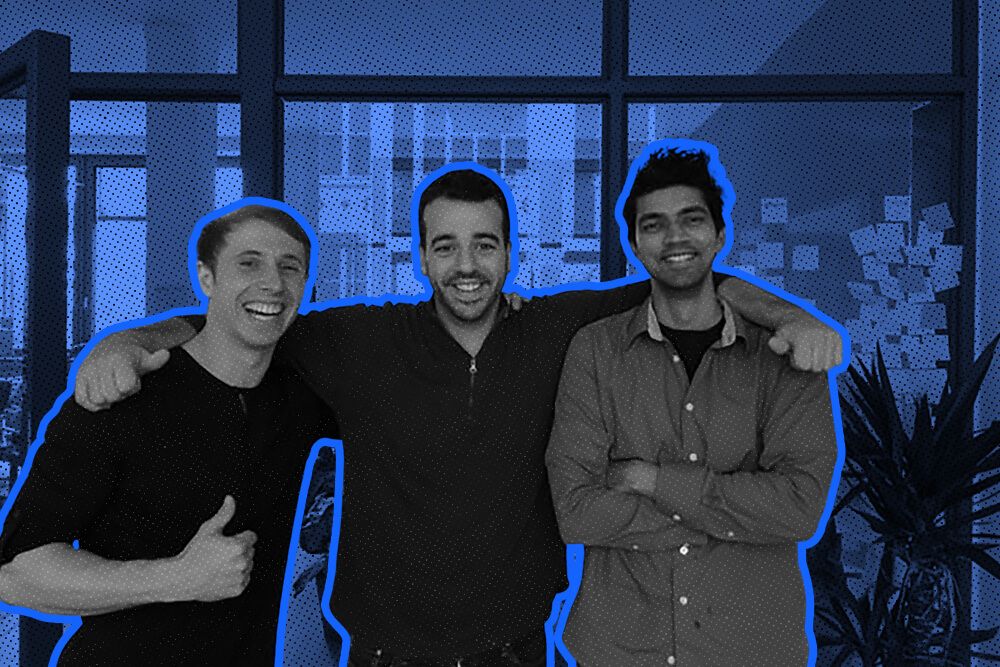
When was the last time you visited a customer? Customer visits might seem extravagant and unnecessary on the surface.
Why not just get on a phone call or Zoom meeting? Or follow up with them via email? You could just send them a survey, or even dig into your product analytics to surface insights.
That said, if I’m talking to another entrepreneur and say something like, "It's super crucial you physically visit your customers", they all look at me as if I just said the most obvious thing in the universe.
Visiting customers is like working out or eating healthy: everybody knows they should do it, but very few people actually do.
And we’re not excluding ourselves here: We launched Close in January of 2013, but our first customer visit was more than a year later!
Some businesses put off visiting customers because it takes time, and it’s easy to push down on your long to-do list. Or, it may seem more urgent to focus on getting new customers to sign on, rather than visiting existing customers.
If this sounds like you, let’s discuss the benefits of visiting your customers, and how you can set up successful customer visits.
What Are the Benefits of Visiting Your Customers in Person?
It’s true: COVID has permanently altered the way B2B sales works. Studies by McKinsey show that companies have reduced their in-person efforts as a go-to-market strategy by more than 50 percent since the pandemic started.
That said, a decent number of B2B buyers still prefer in-person contact during the customer journey.
And this is exactly where the opportunity lies—fewer companies are vying for your customer’s attention in person. This opens the playing field for your company to perform more customer visits.
And trust me—it’s worth the effort. Here's a quick rundown of the value we got from our first customer visits.
Motivate Your Team to Serve Customers Better
Seeing real people use your product is incredibly inspiring. It energizes you. It recharges your batteries. It gives you a visceral sense of how your work actually impacts the life of your users, rather than just an intellectual understanding. It's like pouring gasoline on the fire that fuels your engine.
Everybody on your team—from the CEO to the intern—should visit a customer, for this reason alone.
It is different from hearing customers tell you how much they love your product or how great they think it is. You just have to experience customer satisfaction happening in real-time. You need to see real human beings depending on what you built. You need to witness how your product helps them to operate better, to be better at what they are doing.
The impact you make on other people's lives is a much stronger driver than any number on a spreadsheet can ever be. Do not underestimate how much this affects you. It's powerful.
Build Better Customer Relationships
Meeting someone in person adds another dimension to your relationship with your customer. You can do a lot of relationship-building via email, chat, phone, and Zoom, but nothing has the same effect as meeting someone in person. It creates a human bond between the two of you.
Jason Lemkin of SaaStr says he never lost a customer whom he had personally visited while he was CEO of EchoSign. Spending time with your customers transforms a transactional relationship into a partnership. It builds empathy on both sides, which ultimately leads to better business.
In-person customer visits are one of the best ways to build customer intimacy . It deepens the commitment on both sides. If one of the people we met needs help one day, we'll be more eager to support them. And I'm pretty sure they'll be more forgiving if there's ever an issue with Close and be more loyal to our product.
Get In-depth Product Feedback on the Customer Experience
Your customers are more than the sum of all their clicks on your product. Yes, you might be monitoring product usage and reading all the feedback people send you via email or even tell you on the phone, but you're missing a lot of crucial context if you can't see your customers using your product within their work environment.
- How exactly are they using your product?
- What's happening around them?
- What else is on their screen?
- What's competing for their attention?
- What's their workspace like?
When you visit your customers, you get to see the environment in which they use your software. You experience your product embedded into a user's workday and get a sense of the entire puzzle, rather than just a single piece of it.
And it's little things, like...
- What kind of headsets /chairs/desks are they using?
- What other software/apps are they using during their day?
- Which little hacks did they come up with to make them more productive and efficient?
- What makes them smile, and what makes them frown when interacting with your web or mobile app ?
It just gives you a better picture of what's working and what's not.
Here’s a real example: during one customer visit, we saw that the customer was using a TV to display our reporting in Close . But at the time, our reporting page wasn’t optimized for full-screen display—it looked crappy.
I remembered that one of our engineers had worked on a quick fix that would make this look better, but we had never released it. I sent a message to the team, and within an hour, this feature was released by our VP of Engineering, Phil Freo . It looked fantastic, and our customers loved it.
While visiting customers, you can gather more in-depth feedback about how they’re using your product and where they would like to see improvements in the customer experience. Product managers can then use this information to build out improvements.
Find Opportunities to Upsell
Years ago, during one customer visit, we found the customer was on a basic plan that didn’t include a specific feature. Instead, they were using a third-party provider to get this feature for their sales team.
Talking with the founder, we faced some resistance to upgrading their plan. But we gained an internal champion during that customer visit by chatting with the sales team manager. We gave him everything he needed to make the transition happen, and they soon upgraded their plan to start using this feature again.
Visiting customers in Germany in 2015
This is the power of in-person visits—not only did the extra revenue help us, but by upgrading their plan, the customer’s success with our product was significantly increased.
Create New Case Studies and Customer Stories
Using case studies and real-life examples of how your customers use your product is an excellent digital marketing strategy and one that will help build trust in your brand.
When planning customer visits, think about the customers you may want to interview for video testimonials or case studies on your website. Having these real customer stories also helps build better marketing alignment with your ideal customers and their needs.
All of these are examples of the kinds of benefits you can get from visiting your customers. You can't predict which benefits precisely you'll get—but you will always get value from a customer visit!
Get Your Copy of Talk to Your Customers →
How to Plan a Client Visit That Boosts Customer Loyalty in 7 Steps
By now, you should be sufficiently motivated to actually visit your customers. But what do you say and do? How do you get the most value out of these visits? How do you prepare for them? How do you wrap them up? How do you get started when you visit their office?
1. Identify Which Customers to Visit
Whether you have 10 customers or 10,000, it’s probably not feasible to visit everyone. So, which customers should you visit?
To start, make a list of the customers who already have a good rapport with you—your partners, advocates, and overall best customers.
Next, include customers who are using your product or purchasing from you on a regular basis. Learning about how they use your products and services, or why they keep coming back to you, will be great for your team.
Finally, make sure to include the customers who consistently give you critical feedback. These customers are already pushing your team to do better, and they will likely have super valuable insights to share with you when you visit in person.
2. Decide Who You’re Meeting With
Once you know which companies you’ll visit, decide which individuals inside the company you’ll need to meet with.
First of all, you set up a meeting with the founders or CEO. That's the person you'll be officially meeting. But it's not necessarily the person you'll spend most of the time with.
For SaaS companies, focus on the person managing the team that's using your product, as well as the end-users. If you’re a service-based business, talk to the people who are mainly affected by using your services.
The Close team visiting customers in Ottawa, Canada, 2014
3. Spend Time Getting to Know the Business Beforehand
Just like when prospecting, spend time doing research before the meeting—whether that’s on social media sites like LinkedIn, on the company’s website, or in B2B databases like Crunchbase.
When you walk into that client visit, you should know exactly who you’re talking to, what kind of business they are, which customers they serve, and how your product or service fits into that workflow.
4. Prepare and Share an Agenda
Having a clear agenda for your customer visit is essential to get the most out of the time you spend with your customers.
Start by setting out the agenda for your main meetings with the C-suite and with the managers of the teams that use your product. Set up talking points: such as updates to your product pricing, or upcoming feature launches in your product. Also, leave room in the agenda for their team to add any questions or comments. Leave a clear space for them to give you feedback.
Once your customer visit agenda is prepared, share it with their team. Let them have editing access so they can include their ideas. Make sure that expectations between you and your customer are aligned before you start asking them a lot of questions. Create a setting that encourages them to discuss and share their concerns openly.
Also, make sure to discuss confidentiality. If you plan to report back to your team after your customer visit, explicitly ask them if they're fine with you sharing their business processes, revenue numbers, etc, with your team. (If not, that's fine too—you can still share the learnings, without actual specifics, with your team.)
That way, both teams will be ready to get started when the day comes.
5. Learn About the Customer Experience in Real Time
So, the day of your customer visit has finally arrived! Start by talking in general, broad terms about their business and your business. Then, progress to more specific topics and product use cases.
Be both a student and a mentor. Learn as much as you can about your customers, and look for opportunities to help them. Learn about their workflows, and your product fits into those workflows.
Here are some questions you might ask during a client visit:
- How often do you use our product?
- Which team members use our product the most? How often do they use it?
- Are there secondary users that only use our product occasionally? If so, for what? How often?
- What are your business goals?
- How do you implement our product in your daily workflow?
- What bugs have you encountered?
- What features are you missing within our product?
- What do you like most about our product?
- What do you hate about our product? Which limitations do you find particularly frustrating?
- Which metrics does your team track within our product? (Or which KPIs does our product impact for your team?)
- If our product ceased to exist tomorrow, what alternatives would you consider to replace us?
- Are there any trends or changes in the industry that could affect the way you use our product in the future?
These questions and others like them will give you a clearer picture of how your customers use your product, and how it impacts their business.
The Close team doing a customer visit
6. Ask for and Give Referrals
Visiting customers is a great opportunity to get referrals . And to refer them to others as well. Don't just limit referrals to potential customers—any reason to put them in touch with other people is fair game, as long as you can see potential value for both parties.
Sometimes we see companies serving the same audience with complementary services—that's potential for a co-marketing initiative. If you introduce two happy customers to each other, and they collaborate together, and both get a ton of value out of it, you generate a lot of goodwill, and oftentimes very vocal brand advocates.
If you have a partner program set up, try to see if the customer you’re visiting would be a good candidate for that program, and help them understand how it works and the benefits they could get.
7. Create a Customer Visit Report for Your Team
If you do conduct a customer visit, make sure to document your learnings and take note of memorable moments. Then, you can share these insights with your team.
It's important that all the insights you gain during a customer visit actually become organizational knowledge—otherwise, your customer visits are basically useless.
So, set up a structured customer visit report that your team can peruse and learn from, both now and in the future. Inside this document, note specific items that will be of interest to the different teams in your company—for example, product feedback that your product managers may want to look at, customer journey insights that the marketing team should keep in mind, or product knowledge gaps that the customer success team may need to address.
To make sure everyone in the company benefits from customer visits, we try to share some pictures or highlights from our customer visits in Slack, and then during our weekly team meeting, a team member might give a quick 2-minute summary of their customer visit.
How Often Should You Plan Customer Visits?
There's no one-size-fits-all formula. It depends on your startup, but in general: you should meet them more often than you're meeting them now.
Jason Lemkin recommends every co-founder, CEO, and Customer Success Manager should meet on-site with five customers a month.
Being able to see the environment in which your customers use your product, the atmosphere at their workplace, and talking with the people who use your product daily is always an insightful experience.
Customer visits have been a crucial market research method for traditional businesses for many decades—but they're even more crucial for startups and SMBs . Your most powerful asset when you're in a market with established, large companies is your ability to understand your customers better and focus on their needs better than a large corporation can.
Michael Seibel, Managing Director at Y Combinator, said : "If you look around the startup ecosystem, you can find too many founders who believe that famous investors + lots of employees = winning. I bet most of our VC-backed competitors feel this way, and you can use this to defeat them (they aren't talking to customers nearly enough).”
Want more insights on talking to your customers? Get my book and learn more about building customer intimacy.

More articles from The Close Blog

Discover our latest free sales tools powered by AI
Learn from the sales pros with our free sales guides.
Supreme Court wrestles with abortion clash over emergency room treatment for pregnant women
WASHINGTON — The Supreme Court appeared divided Wednesday as it grappled with whether provisions of Idaho's near-total abortion ban unlawfully conflict with a federal law aimed at ensuring certain standards for emergency medical care for patients, including pregnant women.
Some conservative justices, who have a 6-3 majority, appeared skeptical about the Biden administration’s lawsuit arguing that the state ban restricts potentially lifesaving treatment for women suffering complications during pregnancy.
Liberal members of the court appeared to back the administration's position.
The justices are weighing an appeal brought by Idaho officials who are contesting a lawsuit the Biden administration filed over abortion access in emergency situations.

The state abortion law was enacted in 2020, with a provision stating it would go into effect if the Supreme Court overturned Roe v. Wade, the 1973 ruling that found women had a constitutional right to abortion.
The 2020 law, called the Defense of Life Act, went into effect in 2022 when the Supreme Court rolled back Roe.
The state law says anyone who performs an abortion is subject to criminal penalties, including up to five years in prison. Health care professionals found to have violated the law can lose their professional licenses.
The federal government sued, leading a federal judge in August 2022 to block the state from enforcing provisions concerning medical care that is required under the federal Emergency Medical Treatment and Labor Act, or EMTALA.
The federal law, enacted in 1986, requires that patients receive appropriate emergency room care. The Biden administration argues that care should include abortions in certain situations. The law applies to any hospital that receives federal funding under the Medicare program.
There is an exception to the Idaho law if an abortion is necessary to protect the life of the pregnant woman, although the scope of the exception came under close scrutiny during the oral argument.
Idaho’s lawyer, Joshua Turner, faced tough questioning about whether the exception can also apply to a situation in which a woman has complications that pose a substantial health risk but not imminent death.
Liberal Justice Elena Kagan said federal law says “that you don’t have to wait until the person is on the verge of death.”
“If the woman is going to lose her reproductive organs, that’s enough to trigger this duty on the part of the hospital to stabilize the patient,” she said.
Fellow liberal Justice Sonia Sotomayor asked similar questions, providing several examples of real-life situations in which women have faced emergency situations when doctors had to make calls about whether to authorize abortions, including a situation in which a patient at 16 weeks of pregnancy whose water broke was at risk of sepsis or a hemorrhage after she was refused an abortion in Florida.
"Is that a case in which Idaho the day before would have said it's OK to have an abortion?" Sotomayor asked.
Turner argued that such medical decisions are “subjective” and that a doctor’s judgment in such instances would be based on good faith, not an objective standard.
Justices Amy Coney Barrett and Brett Kavanaugh, both conservatives, indicated they saw Idaho’s law as allowing for treatment similar to what the Biden administration says the federal law requires, suggesting that there may not be any conflict.
At one point Barrett said she was "shocked" at Turner's answers to questions about what kind of treatment was allowed, because "I thought your own expert had said below that these kinds of cases were covered."
Kavanaugh likewise questioned the daylight between the two laws, wondering what the implications are if "Idaho law allows an abortion in each of the emergency circumstances that is identified by the government."
"What does that mean for what we're deciding here?" he asked Turner.
Conservative Justice Samuel Alito seemed most skeptical of the federal government's argument, at one point mentioning language in the federal law referring to treatment for an "unborn child," a term more commonly used by anti-abortion advocates.
"Isn't that an odd phrase to put in a statute that imposes a mandate to perform abortions?" Alito asked Solicitor General Elizabeth Prelogar.
"Have you seen abortion statutes that use the phrase 'unborn child'? Doesn't that tell us something?"
Prelogar responded that the phrase did not displace the requirement that women get the treatment they need in emergency situations.
Conservative justices, including Neil Gorsuch, also questioned whether the federal government even has the power to mandate health standards when they are tied to Medicare funding.
In January, the Supreme Court allowed Idaho to enforce the provisions while also agreeing to hear oral arguments in the case. Other provisions of the ban are already in effect and will not be affected by how the justices rule.
The decision will affect not just Idaho but also other states, including Texas, that have enacted similar abortion bans that abortion-rights advocates say clash with the federal law.
In blocking parts of the state law that conflict with federal law, U.S. District Court Judge B. Lynn Winmill described the state’s actions as putting doctors in a difficult situation.
“The doctor believes her EMTALA obligations require her to offer that abortion right now. But she also knows that all abortions are banned in Idaho. She thus finds herself on the horns of a dilemma. Which law should she violate?” he wrote.
The San Francisco-based 9th U.S. Circuit Court of Appeals briefly put Winmill’s ruling on hold in September, but it subsequently allowed it to go back into effect, prompting the state officials to turn to the Supreme Court.
Prelogar wrote in court papers that EMTALA requires "necessary stabilizing treatment," which in cases involving pregnant women in emergency situations may require abortions.
"And in those limited but critically important circumstances EMTALA requires the hospital to offer that care," she added.
The state argues that it was only after Roe was overturned that the Biden administration said EMTALA could be interpreted to require abortions in some contexts, calling it a "nationwide abortion mandate."
EMTALA "merely prohibits emergency rooms from turning away indigent patients with serious medical conditions," Idaho Attorney General Raúl Labrador wrote in court papers. The law was not intended to override state laws regulating health care, he added.
The Idaho dispute is one of two abortion cases now pending at the Supreme Court, both of which arose in the aftermath of the 2022 decision to overturn Roe v. Wade. In the other case, the court is considering a challenge that could restrict access to mifepristone, the drug most commonly used for medication abortions.
Lawrence Hurley covers the Supreme Court for NBC News.

IMAGES
VIDEO
COMMENTS
site visit: 1 n a visit in an official capacity to examine a site to determine its suitability for some enterprise Type of: visit the act of going to see some person or place or thing for a short time
A site visit is a physical inspection of a construction site. It's an opportunity for the project team behind the build to see the work in progress and to identify any potential problems. They can be conducted by the project manager, the engineer, the architect or any other member of the project team. There are many benefits to conducting ...
Site visits occur at the recipient's office or program. location or can be done virtually, if there are scheduling or traveling issues. Site visits are intended to review the capacity, performance, and compliance of the recipient. Site visits allow the awarding agency. procedures, audit compliance records, and internal controls.
A site visit is a visit to a construction site. Site visits are usually conducted by clients, architects, and other stakeholders before the project is complete. Site visits can be done in person or virtually using 3D models or video. Site visits are often used to review construction progress, identify potential risks and hazards, and confirm ...
Construction site visits are crucial for ensuring safety, compliance, and quality control on a project. These visits allow for inspections, assessments, and evaluations to be conducted, which can help identify and resolve any issues that may arise. By having a clear understanding of the project's progress, stakeholders can make informed decisions that will keep the project on track and within ...
A site visit can be one of the most important tools you use, as a grantmaker, in determining your ultimate funding decisions. For example, an in-person look at a potential grantee's activities can complement a grantee's written proposal and give you a clearer picture of their request. In fact, site visits can be one of the most interesting parts of the grantmaking process.
A site visit analysis is a comprehensive report that summarizes the findings of a physical inspection of a potential development site. It includes information on the site's physical characteristics, location, surrounding area, demographic information, environmental impact, zoning regulations, traffic flow, and recommendations for development. ...
Whether you are just starting out in the field of architecture or an architect with 40 years of experience, site visits play a central role to our professional development. Most of the times, site visits take place during the construction phase of a project. It is during this stage where a team of multidisciplinary professionals physically get together to realize things previously drawn on ...
Site visits are invaluable for gathering details that will strengthen your quality responses, especially those that focus on Health & Safety, Contract Implementation and Risk Assessment & Mitigation. You can clarify any doubts that you may have about the information provided in the tender documents. This will again help you in your journey ...
The purpose of the "Differing Site Conditions" clause is to transfer unknown risks to the Government as provided under FAR 52.236-2. Id . In the majority of cases, the "risk" pertains to any of the physical conditions mentioned above that were not known to exist at the time of bid. It is important to note that if the access to the site ...
A Site Visit involves preparation and follow-up in the classroom, including research and reflection by students. Tours generally last between an hour-and-a-half to two hours. Purpose. Site visits provide an opportunity for students to learn about an industry, potential career opportunities, and jobs. The activities are designed to:
Define site visit. site visit synonyms, site visit pronunciation, site visit translation, English dictionary definition of site visit. Noun 1. site visit - a visit in an official capacity to examine a site to determine its suitability for some enterprise visit - the act of going to see some...
Purpose of Site Visits. As our definition suggests, a critical early step in conducting evaluative site visits is to identify the purpose of the visit. As suggested by Patton (1997), involvement of relevant stakeholders in the identification of the purposes will enhance the usability of the final report. We believe that site visits can serve ...
Understanding Page Views vs. Visits. A page view occurs when a page on your website is loaded or reloaded whether the user was already on your page or came from an external page. A page visit, on the other hand, only occurs when someone lands on your site from an external page, such as Google or another website.
You can evaluate the frequency of visits, the retention rate or the terminals used. Unique visitors are identical to visitors on a daily basis (Day 1: Unique visitors = Visitors = 3). If we now consider a period of several days, we obtain 8 Visitors (3+1+2+2+2+2, the Day Visitors are added together), and 3 Unique Visitors (deduplicated).
Select the button to download 90-days data for unique viewers, site visits, popular platforms and site traffic. For popular content on the site (news posts, documents and pages) the report will be for last 7 days. To export a site usage report, select the download icon near the right hand corner of the page:
visit: [verb] to pay a call on as an act of friendship or courtesy. to reside with temporarily as a guest. to go to see or stay at (a place) for a particular purpose (such as business or sightseeing). to go or come officially to inspect or oversee.
definition. Site Visits. Means the site visits to the "building" for the purposes of performing " maintenance work " and inspections to verify that the "equipment" and "space" has been used and maintained in accordance with the Agreement. Site Visits. CONSULTANT shall visit the sewer rehabilitation site up to six (6) times at ...
Site Visit means a visit by a DOA staff member, or its designee, to an applicant 's business facility or job location. Site Visit means an individual visit ( user session) to Customer's SAP Portal service, by a User. Within a single Site Visit the User can browse an unlimited number of pages belonging to that site.
Visit definition: to go to and stay with (a person or family) or at (a place) for a short time for reasons of sociability, politeness, business, curiosity, etc.. See examples of VISIT used in a sentence.
A visit starts when the user first arrives on your site. A visit ends when they meet any of the following criteria: 30 minutes of inactivity: Almost all sessions end in this manner. If more than 30 minutes lapse between hits, a new visit begins. 12 hours of activity: If a user consistently fires image requests without any 30-minute gaps for ...
SIV Definition: Site initiation visit. An SIV (clinical trial site initiation visit) is a preliminary inspection of the trial site by the sponsor before the enrollment and screening process begins at that site. It is generally conducted by a monitor or clinical research associate (CRA), who reviews all aspects of the trial with the site staff ...
VISIT definition: 1. to go to a place in order to look at it, or to a person in order to spend time with them: 2. to…. Learn more.
Get In-depth Product Feedback on the Customer Experience. Your customers are more than the sum of all their clicks on your product. Yes, you might be monitoring product usage and reading all the feedback people send you via email or even tell you on the phone, but you're missing a lot of crucial context if you can't see your customers using your product within their work environment.
The Supreme Court considers whether Idaho's near-total abortion ban conflicts with a federal law aimed at ensuring certain standards for emergency medical care for patients, including pregnant women.